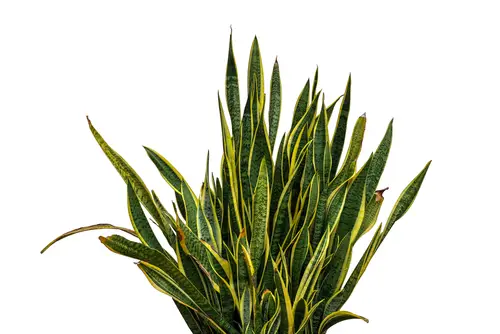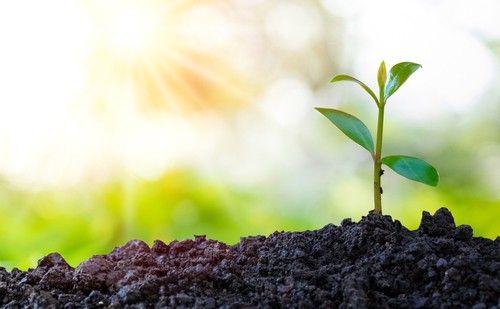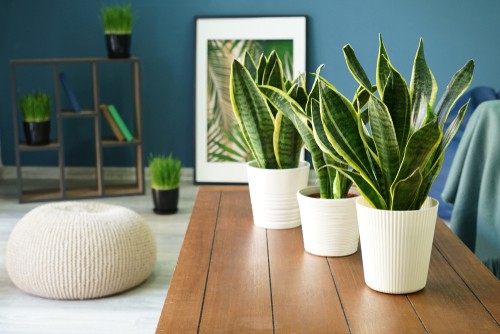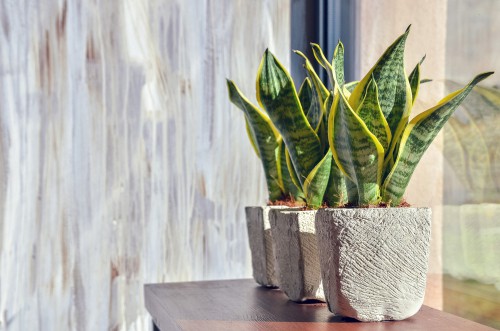Snake plants are a popular houseplant choice due to their low maintenance and air purifying qualities. However, it’s not uncommon for snake plant owners to notice their snake plant have brown tips. This can be frustrating, especially when you’re doing everything else right in terms of care. But why does this happen?
Identifying the cause of brown tips on snake plants is the first step in solving the problem. Underwatering and low humidity are common culprits, as the plant’s xylem tissue is unable to transport nutrients and food to the tips of the leaves when there is a water shortage.
Over-fertilization, inappropriate lighting conditions, and pest infestations can also cause brown tips. It’s important to note that brown tips can also be a sign of natural aging, so it’s important to rule out other causes before assuming the worst.
Preventing brown tips on snake plants involves proper care techniques, such as watering only when the potting soil has completely dried out and providing adequate humidity levels.
Treating brown tips may involve cutting off the browned portion of the leaf and adjusting care techniques accordingly. By understanding the common causes of brown tips and taking preventative measures, snake plant owners can enjoy healthy, vibrant plants.
Key Takeaways
- Brown tips on snake plants can be caused by underwatering, low humidity, over-fertilization, inappropriate lighting conditions, and pest infestations.
- Proper care techniques, such as watering only when the potting soil has completely dried out and providing adequate humidity levels, can prevent brown tips from occurring.
- Treating brown tips may involve cutting off the browned portion of the leaf and adjusting care techniques accordingly.
Similar posts:
- Why Does My Rubber Plant Have Brown Spots?
- Why Does My Prayer Plant Have Yellow Leaves?
- Why Does My Monstera Plant Have Water Droplets?
Identifying Brown Tips on Snake Plant

Brown tips on snake plant leaves are a common issue that many plant owners face. It is a warning sign that something is not right with the plant’s health. Identifying the brown tips is the first step towards fixing the problem.
The brown tips on snake plant leaves are easy to spot. They appear as dry, crispy, and brown edges on the leaves. In severe cases, the brown tips may extend to the entire leaf, leading to the death of the plant.
Brown tips on snake plants are caused by various factors, including stress, overwatering, underwatering, lighting, and pests. Stress is the most common cause of brown tips on snake plants. When a snake plant is stressed, it diverts its resources to the essential parts, leaving the tips to dry out and turn brown.
It is essential to note that not all brown tips are a sign of an unhealthy plant. Sometimes, the brown tips may be a natural occurrence, especially in older leaves. However, if the brown tips are widespread and affecting many leaves, it is a sign that the plant is not healthy.
Common Causes of Brown Tips
Snake plants are one of the easiest plants to care for, but even they can develop brown tips. Here are some common causes of brown tips on snake plants:
1. Overwatering and Underwatering
Overwatering or underwatering can cause brown tips on snake plants. Snake plants only need to be watered when their soil has completely dried out. If the soil is kept too wet, the roots can become waterlogged, and the plant can develop root rot.
On the other hand, if the soil is too dry, the plant can become dehydrated, and the tips of the leaves can turn brown.
2. Improper Soil and Drainage
Snake plants need well-draining soil to prevent water from sitting around the roots. If the soil is too heavy or compacted, or if the pot doesn’t have drainage holes, excess water can accumulate, causing the roots to rot and the leaves to turn brown.
3. Temperature and Light Conditions

Snake plants prefer warm temperatures and indirect sunlight. If they are exposed to direct sunlight or drafts, they can become stressed and develop brown tips. Inconsistent watering and low humidity can also cause stress.
4. Pests and Diseases
Pests like spider mites, mealybugs, and thrips can infest snake plants and cause brown spots on the leaves. Fungal diseases like root rot and leaf spot can also cause brown tips. Tap water can contain chlorine and other chemicals that can damage the plant, causing brown spots and leaf burn.
Preventing Brown Tips
Snake plants are hardy and low-maintenance plants that can survive in various conditions. However, they can develop brown tips for several reasons, including watering issues, poor soil quality, inadequate light, pests, and diseases. Here are some tips to prevent brown tips and keep your snake plant healthy.
1. Proper Watering Techniques
Consistent watering is crucial to keep a snake plant healthy. Overwatering or underwatering can cause brown tips or other issues. It is essential to allow the soil to dry out completely before watering the plant. A moisture meter can help determine when the soil is dry enough for watering.
When watering, it is crucial to use chlorine-free water to avoid damaging the plant. Also, ensure that the pot has proper drainage to prevent water from sitting at the bottom of the pot, which can lead to root rot.
2. Choosing the Right Soil and Pot
Snake plants prefer well-draining soil to prevent waterlogging, which can cause brown tips and root rot. A well-draining potting soil mixed with sand or perlite can provide adequate drainage for the plant.
Choosing the right pot is also essential. Snake plants prefer pots that are slightly bigger than their root ball. A pot that is too big can retain too much moisture, leading to root rot and brown tips.
3. Maintaining Ideal Temperature and Light
Snake plants thrive in indirect light, and they can tolerate low light conditions. However, too much direct sunlight can scorch the leaves, leading to brown tips. Placing the plant near a window that receives bright but indirect light can provide the ideal light conditions for the plant.
Snake plants prefer temperatures between 60-85°F (15-29°C). Avoid placing the plant near drafts or air conditioning vents, which can cause temperature fluctuations that can stress the plant.
4. Preventing Pests and Diseases

Pests and diseases can cause distress to the plant, leading to brown tips or other issues. Regular maintenance, such as pruning, can help prevent pest infestations. Also, acclimatizing the plant to its new environment can prevent stress and diseases.
Maintaining proper humidity levels can also prevent pests and diseases. Snake plants prefer low to medium humidity levels, and using a humidifier can help maintain ideal humidity levels.
Treating Brown Tips
When a snake plant’s leaves develop brown tips, it is an indication that something is not right. Here are some tips on how to treat brown tips on a snake plant.
1. Trimming and Pruning
Trimming and pruning are necessary steps to treat brown tips on a snake plant. The damaged leaves should be removed with a sharp and clean pair of scissors or pruning shears.
Cut the leaves just below the brown tips, making sure not to damage the healthy parts of the plant. This will not only make the plant look neater but also prevent further damage caused by the dead tissue.
2. Adjusting Watering and Feeding
One of the most common causes of brown tips on snake plants is watering problems. Overwatering can lead to root rot, while underwatering can cause dehydration and stress.
To avoid these problems, snake plants should only be watered when the soil has completely dried out. It is also important to use a well-draining soil mix and a pot with drainage holes.
Feeding is also important for snake plants, but too much fertilizer can cause brown tips and other problems. Make sure to follow the recommended dosage and frequency of fertilizer application. Also, avoid using chloramine-treated water, which can cause blistering and other issues.
3. Repotting and Soil Change
Repotting and soil change can also help treat brown tips on snake plants. If the plant is root-bound, it may need to be repotted to give it more space to grow. Use a fresh soil mix that is well-draining and nutrient-rich. Avoid using heavy soils that can retain too much moisture and cause root rot.
4. Addressing Pests and Diseases
Brown tips on snake plants can also be caused by pests and diseases. Check the plant regularly for signs of infestation, such as mealybugs, spider mites, and scale insects.
If pests are present, treat the plant with an appropriate insecticide or pesticide. Diseases such as root rot can be caused by anaerobic bacteria and can be treated by adjusting watering and soil conditions.
Conclusion

Brown tips on snake plants are a common problem that can be caused by a variety of factors. The most common cause of brown tips is watering problems, which can be either overwatering or underwatering.
Snake plants only like to be watered once their potting soil has completely dried out, and their health can suffer if they are watered incorrectly.
Another common cause of brown tips on snake plants is low humidity. Snake plants like humidity, so it is important to place them in a room with a temperature of about 70 degrees rather than 80 degrees. It is also important to water snake plants often because they do not tolerate droughts very well.
Other factors that can cause brown tips on snake plants include cold sensitivity, inappropriate lighting conditions, environmental factors like drafts, temperature swings or changes to humidity, or disease and pests.
Whatever the cause may be, it is important to identify the problem and take action to correct it in order to keep the snake plant healthy.
Frequently Asked Questions
How to fix brown tips on snake plant?
Brown tips on snake plant are usually caused by underwatering, low humidity, or pests. To fix brown tips, make sure to water your snake plant adequately, provide enough humidity, and check for pests. You can also remove the brown tips with a pair of clean scissors.
Snake plant leaves turning brown and crispy?
If your snake plant leaves are turning brown and crispy, it could be a sign of underwatering. Snake plants prefer well-draining soil, but they still need to be watered regularly. Make sure to water your snake plant thoroughly whenever the top inch of soil is dry.
Snake plant turning brown at base?
If your snake plant is turning brown at the base, it could be a sign of root rot. Root rot is caused by overwatering, which leads to the roots becoming waterlogged and eventually rotting. To save your snake plant, remove it from the soil, trim off any rotting roots, and repot it in fresh soil.
Should I cut brown tips off snake plant?
Yes, you can cut brown tips off snake plant with a pair of clean scissors. This will not harm the plant and will make it look more attractive. However, make sure to address the underlying cause of brown tips, such as underwatering or low humidity, to prevent them from reoccurring.
What does overwatering a snake plant look like?
Overwatering a snake plant can lead to yellowing leaves, soft and mushy leaves, and root rot. The leaves may also become droopy and wilted. To avoid overwatering, make sure to water your snake plant only when the top inch of soil is dry.
Do brown tips mean overwatering?
Brown tips on snake plant can be caused by overwatering, but they can also be caused by underwatering, low humidity, or pests. It’s important to address the underlying cause of brown tips to prevent them from reoccurring.

Hey, I’m Lisa and I’ve been an avid gardener for over 30 years. I love writing, talking and living in the garden! Feel free to connect with me on my socials below


